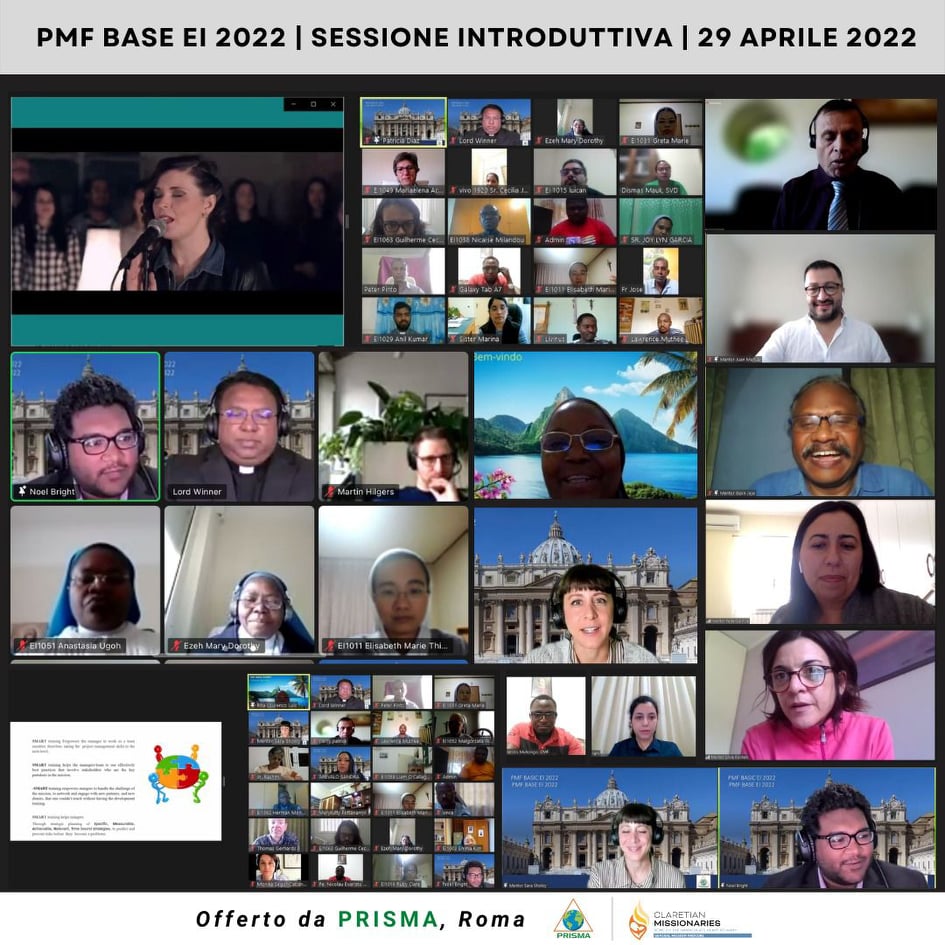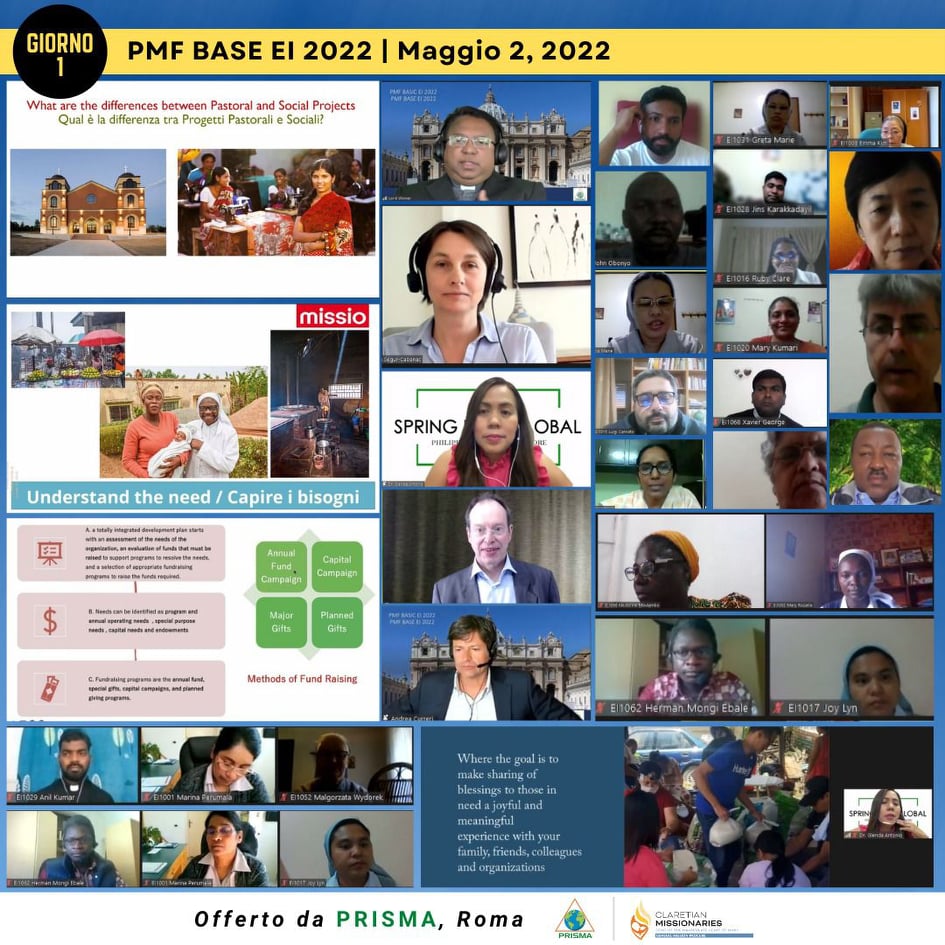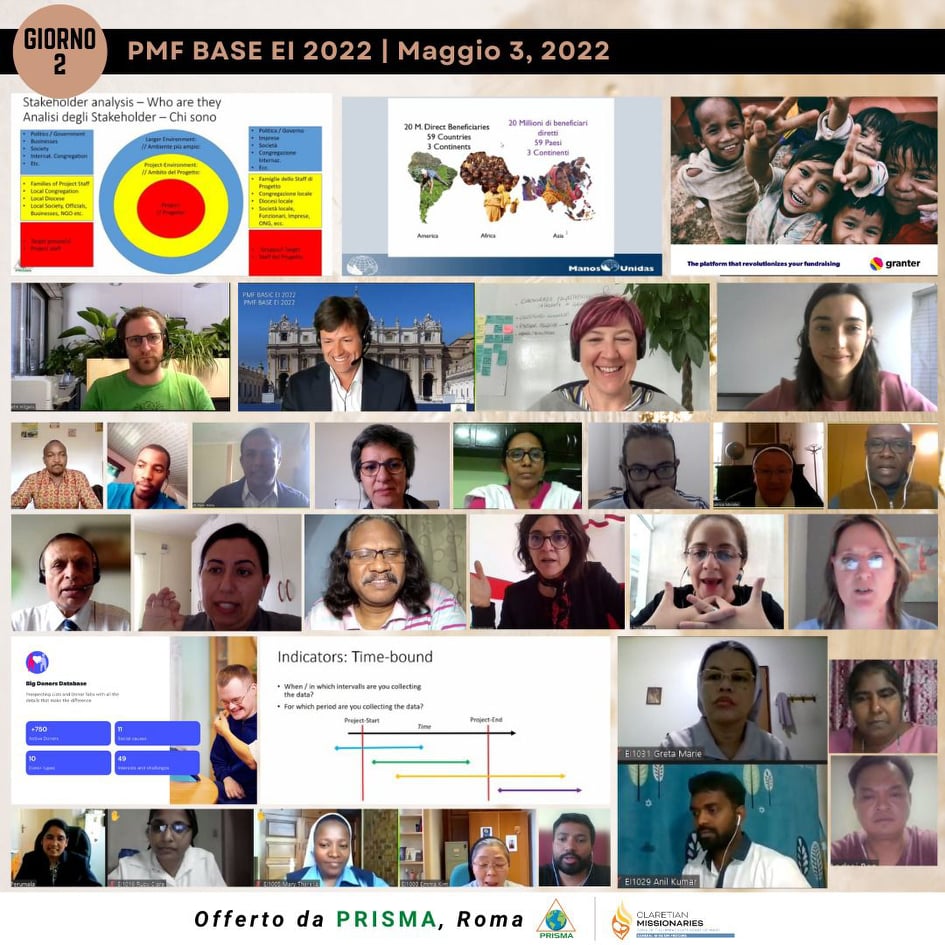
PMF BASIC El 2022: Project Management and Fundraising Training
17 May 2022It is a pleasure to share my experience on “PRISMA” training formation on Project Management. PRISMA is the project management training platform of Claretian Missionaries. The training was conducted through Zoom meetings, hosted in AVISHA Platform, on 2nd, 3rd, 4th, 6th and 7th of May 2022, 5 sessions per day.
A Project is a set of planned activities, within a given time frame which aims at bringing a desired change, through the use of allotted resources.
TOPICS COVERED:
Fundraising for Pastoral and Social Projects, Logical Framework Matrix, Work Breakdown Structure, Gantt Charts, Budgets, Documentation, Reporting, Monitoring, Evaluation, Formats of Pastoral and Social Projects, Congregational Project Offices, Methods of Fundraising, Inputs from Personnel of Pastoral & Social Donor Agencies.
Project Objectives are always connected with Development Goals.

RELIGIOUS CONGREGATIONS AND DIOCESIS IN PROJECT WORK
Religious Congregations and Dioceses projects are want to respond or are
- Based on the Charism of the Founder transmitted through the History of the Congregation; Contextualised through General Chapters and Provincial Chapters; Concretized by Action Plans discussed in Assemblies, Meetings and Community Planning.
- Emergencies also have given rise to new ministries by Congregations as response to disasters.
- Projects remain as a major part of apostolic activities of any Congregation.
PROJECTS IN THE LIFE OF THE CONGREGATION
❖Projects are concrete means to support the existing Apostolates of the Congregation – Can be in the fields Of Education, Health, Social development, Renewable Energy, Disaster Management…
❖Projects can assist to start new ministries as per the signs of the times.
❖Ministry among Migrants, Victims of Trafficking, HIV / AIDs.
❖Projects can also support various needs of Formation of Religious Personnel – Minor Seminary, Novitiate, Juniorate, and Specialization
❖Projects can lead to Financial Sustainability of the Congregations. Project must bring positive Social Change.
Main Project Types: PASTORAL -> SOCIAL SMALL / SOCIAL LARGE
A Pastoral Project: A pastoral project aims on evangelization, strengthening, growth, and spread of catholic faith and structures, like:
- Formation of sisters, brothers, priests;
- Formation of catechists, lay personnel, parish groups;
- Pastoral work in parishes and other places;
- Means of transport for pastoral work;
- Construction/ Renovation of churches and pastoral buildings;
- Mass intentions, rosaries, bibles, religious books/calendars, etc.;
- Assistance and health care for elderly religious persons;
- Income generation for a religious community, congregation or diocese.
A social project intends to assist vulnerable and marginalized groups solving a problem, independent from their faith.

TYPES OF SOCIAL PROJECTS
Disaster Management Projects, Welfare Projects – Charitable Projects, Capacity Building Projects, Livelihood Projects, Rights Based Projects etc.
STEP-BY-STEP PROCEDURE OF A PROBLEM TREE ANALYSIS
1. Identify existing problems i.e. Analyse and understand the real problem (i.e. the “network“ of problems),
2. Define the core problem (focal problem or central point of the overall problem).
3. Formulate the causes,
4. Formulate the effects (consequences) of the core problem
5. Draw a diagram (problem tree)
6. Review the logic and verify the diagram interaction between you and donors. When describing, it is good to use Maps, photograph to understand better the project. The details about the expenses should be budged clearly. Specify how much time each activity is requested.
In the elaboration of the project, you should start clearly which resources are needed? Example: Land?, Money?, Labour?, Know-how? Skills?, Equipment?, Connections/social network?, Do we have the skills to use them appropriately?, How will we prevent misuse?
In the realisation of the project, we should make the difference between progress and impact of our project. Progress shows how activities are done while impact shows what has changed.
Project evaluation: Evaluation brings out the Program Impact. Project evaluation represents a systematic and objective assessment of ongoing or completed projects in terms of their design, implementation and results. Evaluations deal with strategic issues such as project relevance, effectiveness, efficiency in achieving specified objectives, impact and sustainability. Evaluation measures how well project activities have met project objectives and/or the extent to which changes in project outcomes can be attributed to the project.
SUSTAINABILITY
How will we make the benefits last?
Reporting documents
Finally the donors request a periodic justification of the progress of the expenditure (bills and expenses), as well as information on the results that the intervention is achieving. Some agencies are more flexible than others. While some donors request progress reports on a regular basis (monthly, bimonthly, semi-annual or annual), other donors link the delivery of interim reports to the dispatch of each instalments. We should read carefully the donors letters in order to respect agreement about how and when to report. Communicating by emails is the most common way. Voice calls are welcome but usually when are strictly necessary.
You should be prepared in case the donor agency visits the location of the project and your office to see the activities status! Keep the project documentation in order and in a safe place.
In conclusion, Projects remain as a major part of our apostolic activities. We want to respond to the Charism of our congregation, Concretized by Actions.
May the Virgin Mary intercede for us in order to understand every day our mission in the world and what it request.
Nestorine Mbulambo, Rmi

